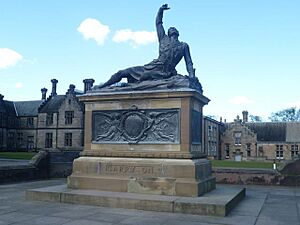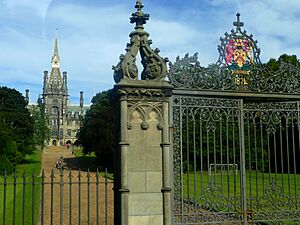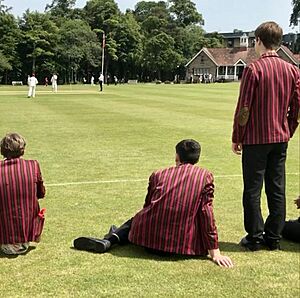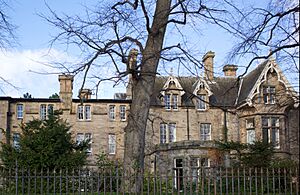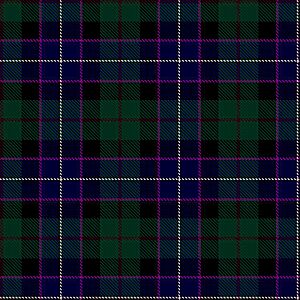Fettes College facts for kids
Quick facts for kids Fettes College |
|
|---|---|
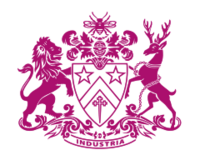 |
|
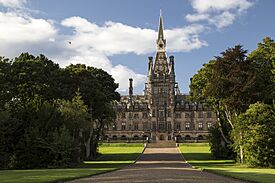
Coat of arms of Fettes College (top)
Fettes College building (below) |
|
| Address | |
|
Carrington Road
, EH4 1QX
Scotland
|
|
| Coordinates | 55°57′49″N 03°13′34″W / 55.96361°N 3.22611°W |
| Information | |
| Type | Public school Private day and boarding school |
| Motto | Industria |
| Established | 1870 |
| Founder | Sir William Fettes |
| Headmistress | Helen Harrison |
| Gender | Mixed |
| Age | 7 to 18 |
| Houses | Carrington, Glencorse, Kimmerghame, Moredun, Arniston, College East, College West, Dalmeny, Craigleith |
| Colour(s) | |
| Mascot | Bee |
| Publication | The Fettesian, The Hive, The Gargolye |
| Alumni | Old Fettesians (OFs) |
Fettes College is a private school in Edinburgh, Scotland. It offers both boarding (where students live at the school) and day school options. Most students live on campus. The school first opened in 1870 as a boys-only boarding school. It became a mixed-sex school, welcoming both boys and girls, in 1983.
Fettes College was started thanks to a gift from Sir William Fettes in 1870. Girls were first admitted for their final year in 1970. The school follows the English education system rather than the Scottish one. It has nine different student houses. The main building, known as the Bryce Building, was designed by David Bryce. Fettes is recognized as one of the best private schools in the world.
Contents
School History
How Fettes College Began
Sir William Fettes (1750–1836) was a rich merchant and a former leader of Edinburgh. He wanted to honor his only son, William, who had passed away in 1815. So, Sir William left a very large sum of money, £166,000, to help educate poor children and orphans.
After Sir William's death, this money was invested. The total amount grew and was used to buy 350 acres of land. This land was then used to build the main school building. Fettes College officially opened in 1870 with 53 students. Forty of these students were "Foundation Scholars," meaning their education was paid for by the fund. Over the years, some parts of the school were rebuilt after fires, like the swimming baths in 1890 and the chemistry lab in 1897. A cricket pavilion was finished in 1906.
Fettes College During Wartime
In the summer of 1914, the school's summer camp had to close. This was because the officers in charge were called to serve in the First World War. Many former students, 1,094 out of 2,000, served in the armed forces. Sadly, 246 of them died during the war. In 1921, a war memorial was put up in the school grounds to remember them. It was designed by Birnie Rhind and has the message "carry on." The main building got central heating in 1920 and electric lights in 1924.
During the Second World War, in October 1939, a German plane flew low over the school's playing fields. It was on its way to bomb a dockyard. One of the school's houses, Kimmerghame House, was used by the navy for mine research. A total of 118 former students died in the Second World War. The school chapel was made bigger in 1948. A new running track opened in 1954, which helped the school's athletics. Queen Elizabeth II and the Duke of Edinburgh visited the school in 1955.
Changes to Land and Admissions
In the early 1960s, Fettes College had to sell some of its land. This was to allow other colleges and police headquarters to be built nearby. In 1965, the school also had to sell land for a new high school. A new dining hall opened in 1966, and a new school library opened in 1970. The Queen Mother also opened a new science school in 1970.
Fettes was an all-boys school until 1970, when girls were first allowed to join for their final year. The school became fully mixed-sex in 1983. In 1988, the school sold more land for homes, which helped pay for improvements to the boys' houses.
Recent School History
In the late 1990s, Fettes College did very well in academics. In 1998, it was ranked fourth in a newspaper's list of schools. In 1999, it was fifth in a list of top mixed independent schools in the UK. In 2001, it was named "Scottish School of the year."
In March 2009, Fettes won the Scottish Schools U18 Rugby Cup for the first time. In April 2009, a report on Fettes called the school "excellent" in most areas. Some people have called Fettes "the Eton of the North," comparing it to another famous school. A former headmaster joked that "Eton College was the Fettes of the South!"
School Life and Learning
What Students Learn
Fettes College follows the English education system. Students take English GCSEs instead of Scottish qualifications. They can choose between A Levels and the International Baccalaureate Diploma.
Life at Fettes includes many sports like rugby, hockey, cricket, golf, tennis, and rowing. In the evenings, students can join various clubs and societies. These include shooting, fencing, debating, drama, chess, music, and robotics.
Fettes is an IB World School. This means it offers the International Baccalaureate program. It is one of only three schools in Scotland with this special status.
Boarding Houses
Fettes College has nine student houses. Four are for boys, four are for girls, and one is for both boys and girls. The houses are named after the estates of the school's first leaders. The boys' houses are large old buildings. Two of the girls' houses are inside the main College Building. The other two girls' houses are in newer buildings on the school grounds. A new house for girls opened in 2012 to help with more students. The Upper Sixth Boarding House, for both boys and girls in their final year, opened in 2007.
Boys' Houses
- Carrington (since 1872)
- Glencorse (since 1873)
- Kimmerghame (since 1920)
- Moredun (since 1870)
Girls' Houses
- Arniston (since 1982)
- College East (since 1984)
- College West (since 1984)
- Dalmeny (since 2012)
Mixed House
- Craigleith (since 2007)
School Buildings and Design
The main building of Fettes College was designed by David Bryce and built between 1863 and 1869. Its design mixes a French Loire château style with Scottish castle features. Experts say it is "undeniably one of Scotland's greatest buildings."
The war memorial, a bronze statue of a fallen officer, was made by Birnie Rhind in 1919.
School Crest and Motto
The school's crest is a bee. This comes from Sir William Fettes's own family crest and his personal seal. When the school got its own crest, it used Sir William's design but with different colors. The bee is also the reason for the school's motto, Industria, which means "hard work" or "diligence." You can see bee designs all around the school buildings.
Fettes Tartan
A special school tartan (a patterned fabric, often used for kilts) was created in 1996. It combines traditional kilt colors like green, blue, and black with the Fettes school colors of chocolate brown and magenta. White stripes add brightness. Boys wear the Fettes tartan as a kilt, and girls wear it as a kilt skirt if they don't have their own family tartan. The tartan was first shown during a school trip to Australia and Japan in 1998.
Fettes in Stories
James Bond's School Days
When the author Ian Fleming wrote about the famous spy James Bond's past, he said that Bond attended Fettes College. This was after Bond left Eton College. Fleming wrote that Fettes had a strict but good atmosphere for learning and sports. Bond made strong friendships and was good at boxing. He also started the first serious judo class at a British public school.
Fleming based some of Bond's character on Sir Alexander Glen, a former Fettes student who was important during the Second World War. There was also a real-life Commander James Bond who went to Fettes and was a frogman, similar to the fictional spy.
Many stories about a young James Bond mention his time at Fettes. One book cover shows a young Bond and his friends leaving Fettes in uniform to help people after a bombing during the Second World War.
Captain Britain's Education
Brian Braddock, who later became Marvel Comics' Captain Britain, was a very smart child. He was chosen to attend Fettes College, where he did very well in his studies. After a difficult event, Brian was given a choice by magical beings: the Amulet of Right or the Sword of Might. He chose the Amulet, which turned him into Captain Britain, a hero for the British Isles.
School Leaders
Since Fettes College was founded, there have been 11 heads of the school:
- 1870–1889 Alexander Potts
- 1890–1919 William Heard
- 1919–1945 Alec Ashcroft
- 1945–1958 Donald Crichton-Miller
- 1958–1971 Ian McIntosh
- 1971–1979 Anthony Chenevix-Trench
- 1979–1988 Cameron Cochrane
- 1988–1998 Malcolm Thyne
- 1998–2017 Michael Spens
- 2017–2019 Geoffrey Stanford
- 2019–present Helen Harrison
Notable Former Students
Many former students of Fettes College have become important people. They include judges, lawyers, diplomats, military officers, and politicians. In sports, many have excelled in rugby. Four former students have won the Victoria Cross, a very brave award. One former student, Sir Angus Deaton, won a Nobel Prize in 2015 for economics. Another famous former student is former British Prime Minister Tony Blair.
See also
- Fettesian-Lorettonian Club


